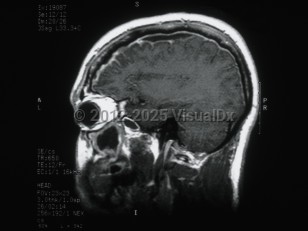Emergency: requires immediate attention
Subdural empyema
Alerts and Notices
Important News & Links
Synopsis

Subdural empyema is a collection of pus in the space between the dura and the arachnoid. Infection of the paranasal sinuses is a risk factor for cranial subdural empyema, as the infection can spread to the space by way of emissary veins. Contiguous spread of infection from osteomyelitis of the skull, meningitis, mastoiditis, or otitis media are also possible. Other etiologies include trauma, seeding of an existing subdural hematoma, or postoperative infection. These infections are typically polymicrobial.
Hematogenous seeding of the space is more likely to result in spinal subdural empyema. This location is less common, accounting for less than 5% of subdural empyema. Staphylococcus aureus is often implicated in infections in this location. Patients may present with fever, headache, and altered mental status (or some combination of these symptoms). Focal neurological signs and seizures may also be present. Magnetic resonance imaging (MRI) with contrast is the diagnostic test of choice.
Treatment is with a combination of surgical decompression and antibiotic therapy. Complications include cerebritis, cerebral abscess formation, and venous sinus thrombosis. Morbidity and mortality in subdural empyema is directly related to delay in therapy.
Hematogenous seeding of the space is more likely to result in spinal subdural empyema. This location is less common, accounting for less than 5% of subdural empyema. Staphylococcus aureus is often implicated in infections in this location. Patients may present with fever, headache, and altered mental status (or some combination of these symptoms). Focal neurological signs and seizures may also be present. Magnetic resonance imaging (MRI) with contrast is the diagnostic test of choice.
Treatment is with a combination of surgical decompression and antibiotic therapy. Complications include cerebritis, cerebral abscess formation, and venous sinus thrombosis. Morbidity and mortality in subdural empyema is directly related to delay in therapy.
Codes
ICD10CM:
G06.2 – Extradural and subdural abscess, unspecified
SNOMEDCT:
37660004 – Subdural abscess
G06.2 – Extradural and subdural abscess, unspecified
SNOMEDCT:
37660004 – Subdural abscess
Look For
Subscription Required
Diagnostic Pearls
Subscription Required
Differential Diagnosis & Pitfalls

To perform a comparison, select diagnoses from the classic differential
Subscription Required
Best Tests
Subscription Required
Management Pearls
Subscription Required
Therapy
Subscription Required
References
Subscription Required
Last Reviewed:04/25/2018
Last Updated:06/11/2018
Last Updated:06/11/2018
Emergency: requires immediate attention
Subdural empyema

